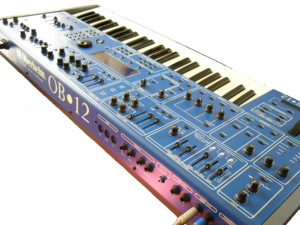Oberheim OB-12
| synthesizer | |
|---|---|

|
|
| General | |
| Surname | OB-12 |
| Manufacturer | Oberheim-Viscount |
| Sound synthesis | digital, virtual-analog |
| properties | |
| Polyphonic | yes, 12 |
| Multitimbral | yes, 4 |
| Oscillators | 2 oscillators per voice. (Sawtooth, triangle and square wave generator) |
| filter | 2 per voice, digital, configurable: low pass , high pass , band pass |
| ADSR | 3 envelope generators, 2 completely designed for filters and amplifiers, 1 simplified for pitch. |
| LFO | 2 per vote |
| Effects | Four effect processors (distortion, chorus, delay, reverb) |
| Keys | 49 keys, velocity sensitive with monophonic aftertouch (single, layer, split mode) |
| Int. Game aids | Pitch, modulation wheel , ribbon controller |
| Interface (noun) | MIDI : 1 × IN, 1 × OUT, 1 × THRU |
| connections | Headphone audio: 1 / L, 2 / R, AUX 1, AUX 2 2 × foot switch 2 × expression pedal 1 × S / PDIF out |
| Sequencer | Phrase sequencer with four memory locations (approx.32,000 notes) |
| Storage spaces | 2 × 128 programs, 2 × 128 timbres |
The OB-12 is a digital synthesizer made by Oberheim Viscount .
Oberheim-Viscount used the name Oberheim for this device (as well as for the stage piano called Cosmos and various other products) . The original founder and owner Tom Oberheim had nothing to do with the conception of this synthesizer. Some fans of the old synthesizer brand were critical of this fact.
In contrast to the original Oberheim synthesizers, the OB-12 works with virtual-analog sound synthesis . This means that it only contains a special processor that digitally simulates the “old” analog circuits. In order for the OB-12 to be able to run this simulation, it needs firmware . In the first versions this was fraught with many errors, which, in addition to the aversion of Oberheim fans to virtual-analog technology, led to bad reviews in the specialist press. The English-language magazine Sound on Sound reported on numerous improvements in a new software version. The last version of the firmware published by the manufacturer has the number 1.52.
The structure of the sound generation follows the model of a classic synthesizer. Two oscillators with different waveforms create the signal, which is then passed through two filters . There are independent envelope generators for the pitch of the oscillators, the cutoff frequency of the filter section and the volume of the tone. Two LFOs can be used at different points for control, with the amplitude of LFO2 being permanently linked to the modulation wheel. The OB-12 has numerous other functions for generating and modifying sound, such as B. a ring modulator and a noise generator.
In addition to the variety of parameters in the sound generation, the device has an arpeggiator , a phrase sequencer and a motion recorder that can record and reproduce changes in the sound. A morphing function allows the automatic fading of one sound into the other. The effects department offers distortion , chorus , delay and reverb . Four sounds can be played simultaneously using the 49-key keyboard. They can be distributed over the keyboard in overlapping layers. The keyboard has velocity and monophonic aftertouch .